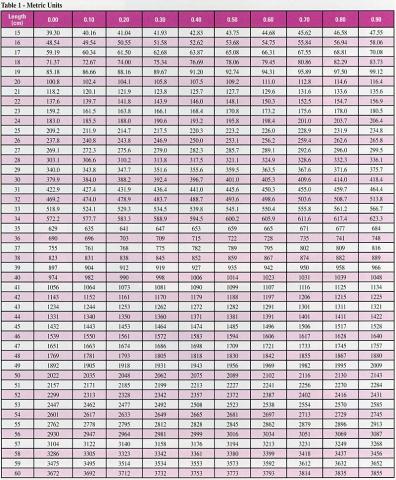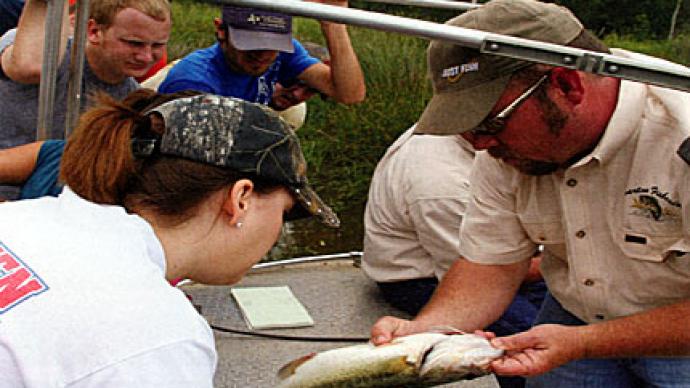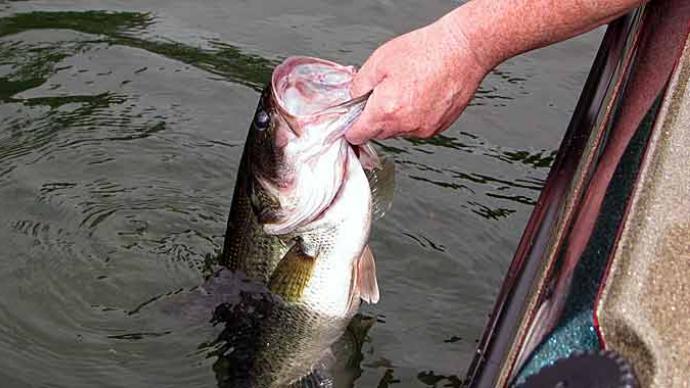
One of the most common problems for pond managers is overly-abundant or "overpopulated" largemouth bass. Our good friend, Dr. Jeff Slipke, of Southeastern Pond Management in Jackson, Tennessee, estimates 90% of ponds he encounters for the first time have overpopulated bass. The same scenario holds true for Texas ponds and for northern ponds.
Overcrowded largemouth bass populations are the number one problem biologists encounter in private waters.
So, how do you recognize overpopulated largemouth bass?
Overpopulated bass are too abundant for their food supply. As a result, they grow slowly, few reach larger sizes and they tend to be skinny.
How then, do fisheries biologists monitor abundance, sizes of fish in the population, growth of fish and the plumpness of fish?
Let's start with abundance.
Most professional pond managers use an electrofishing boat to stun largemouth bass so a random sample can be netted, weighed and measured. Generally speaking, we catch more per unit of electrofishing time when density is high and bass are overcrowded. We call this "catch rate" or "catch per unit of effort" (CPUE) a
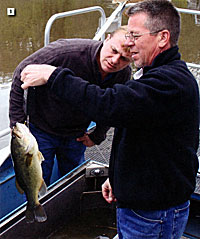
nd often measure it as the number of 8-inch and longer largemouth bass we catch per hour of electrofishing. So, a high catch rate indicates an overpopulated bass population, while low catch rates indicate a lower density population that likely is growing faster and reaching larger sizes.
What is high and what is low?
Well, all electrofishing is not equal. Electrofishing equipment type, whether we sample at night or during daylight hours, what time of year, how experienced the electrofishing crew is, whether we use one or two dippers on the front of the boat and even water quality can all affect catch rates.
However, when we get 100-300 bass per hour, we're pretty confident density is quite high, regardless of methods, weather or the ability of netters to catch fish. Lower density bass populations that are dominated by large fish often may only have catch rates of 10 or 20 per hour. Although these are very general numbers, they should give you an idea of how a fisheries biologist uses catch rate information.
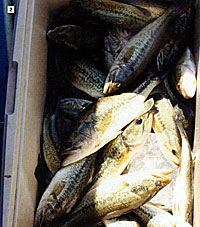
Second, look at size structure of largemouth bass in a pond. In overpopulated situations, few bass reach larger sizes. Again, what constitutes "larger sizes"? In small Midwestern ponds, a low percentage of bass will exceed 12 inches in a high density population. In the worst scenarios we have seen, no bass exceed 12 inches (in one extreme case, the electrofishing catch rate was 303 of the 8-inch and longer bass per hour and none exceeded 12 inches!). Farther south in the United States, and as waters get bigger, we do see a few more bass exceed 12 inches.
The third tool is assessment of growth. Determining fish growth is more time- consuming and requires more experience than other tools in our arsenal. Thus, fish growth is often inferred (guessed at) based on abundance, size structure and condition. We discussed fish growth analysis in the November/December 2010 issue of Pond Boss magazine. Refer back to that issue if you want more information on growth, or let us know if you need a copy of the article.
Our fourth and final tool is fish condition. By condition, we mean the plumpness of the fish. Are they fat or skinny? If they are plump, food resources probably are quite available and we expect faster growth and bigger fish. If the bass are skinny, food is probably a limiting factor. You may have to thin bass numbers to improve condition, growth and allow the fishes to reach larger sizes. Culling bass is a normal recommendation of biologists.
Fisheries biologists most often use relative weight (Wr) to monitor fish condition. This is an easy index to calculate and something you can do on your own pond.
Measure the length and weight of fish you catch. Keep written records. It will pay off for you. The weight of fish you catch is divided by a standard weight for fish of that length. Fisheries biologists have standard weights calculated for many fish species, including largemouth bass. The two tables shown provide standard weight for metric units (where you measure the fish to millimeters [mm] and grams [g]) and for English units (where you measure the fish in inches [in] and pounds [lb]). If you are thinking about purchasing a scale for weighing fish, we recommend getting one that measures grams just because of the finer detail it allows. Many scales allow you to measure either. When measuring in pounds or even tenths of pounds, that tends to be a pretty coarse measure.
Table 1 illustrates the standard largemouth bass weights in metric units. Here's how to use it. Let's say you catch a 293 mm largemouth bass that weighs 230 g. Is that fish skinny, average or plump? Here's how YOU will answer that question. To obtain the standard weight for a fish of this length, look down the left hand column until you get to 29 cm, and then move four squares right out to the 29.3 cm column. You should have found that this fish should weigh 351.6 g. Take your actual fish weight of 260 g, divide it by 351.6 g, and then multiply by 100. Your fish has a Wr of 74. That is indeed a skinny fish!
Table 2 is in English units. These measurements may be more familiar to you. Let's say you caught an 18.6 inch largemouth bass, and it weighed 4.1 pounds. Again, look down the left-hand column until you get to 18 inches, and then move right until you get to the column for 18.6 inches. If you are still with us, you should have found that the standard weight for an 18.6 inch bass is 3.70 pounds. To get the Wr value, divided the actual weight of 4.1 pounds by the standard weight of 3.70 pounds, and multiply by 100. This fish would thus have a Wr of 111. It's not rocket science, is it? You have just caught a plump largemouth bass.
How do biologists interpret Wr values? Again, this is as much an art as a science. However, don't be fooled by the incorrect thought that a Wr of 100 is average. It actually is an above-average value. For most fish species, including largemouth bass, average is about 90-95.
If you are managing for a low density population of fast-growing trophy bass, your Wr values should be above 100 for most of the year. Values of 120 and above are possible for individual fish, although we rarely see a fish much higher than perhaps 140-150.
If you are a Midwestern pond owner and are managing for a crowded largemouth bass population to create big bluegills (8 to 10 inchers) in your pond, then your bass will be slow growing and most will have Wr values below 90. In fact, in truly crowded bass populations, values in the 70s are common and some fish may even get down into the 60s. Any guesses what the Wr values for your bluegills will be under this management strategy? Well, certainly over 100 and very often, we see them get up to at least the 130's!
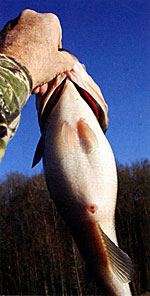
Let's talk a little about sample size. Remember that you need to look at the average Wr for several of your fish of somewhat similar length.
Any individual fish might be much plumper or much thinner than his or her pondmates. Thus, be sure to measure lengths and weights for quite a few fish. Fisheries biologists often try for at least 5 fish per inch group, but you can get by with fewer than that. Monitor fish lengths and weights. You'll quickly get the hang of this and know how many you need. You may also find yourself keeping records from year to year to monitor your population over time! Compare quarterly, semi-annually or annually. That's part of the fun of pond management. Plus, if you see how well your fish are doing, you are being proactive rather than reactive. You can pick up patterns of fish growth. Patterns allow you to project what will happen and you can make adjustments as you go. If your bass are beginning to lose weight consistently, you can choose to harvest some.. .or increase forage fish management.
There are a few cautions about using Wr to understand fish populations. For example, remember that Wr changes seasonally. The easiest example is spawning. Pre-spawn fish tend to be plumper and immediately post- spawn fish can be quite thinner. However, expect them to quickly put on the feed bag after spawn. If food supply is abundant, they will quickly recover Wr values. Also, remember Wr is a relatively short-term measure. You may have fast-growing largemouth bass. However, assume that for a couple of weeks, their food supply is short. If so, Wr values might be low by the end of those two weeks. As soon as food supply recovers, Wr will quickly follow.
So, that's Fish Biology 103. Once again, class dismissed!
Reprinted with permission from Pond Boss Magazine

